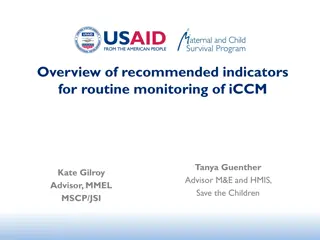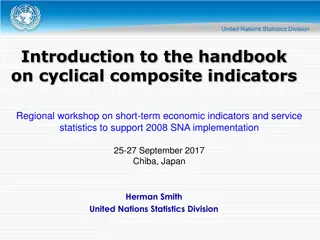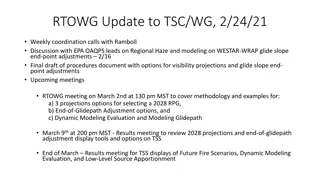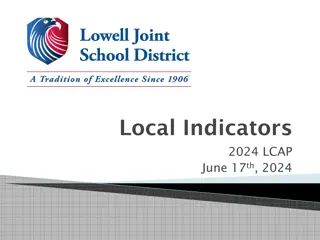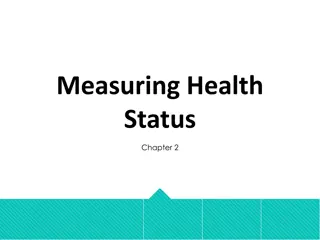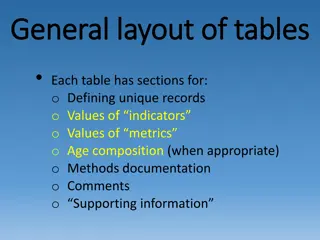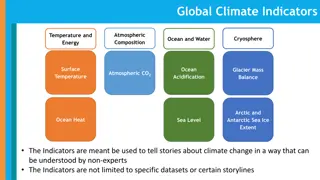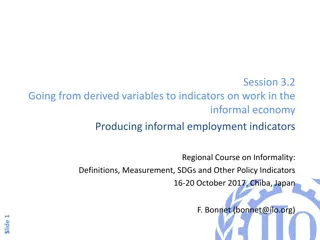Analyzing Socio-Economic Indicators in Regional Economic Modeling
Analysts utilize regional macroeconomic models to assess the impact of policies on various economic factors including employment, income distribution, and workforce demographics. REMI-SEI framework focuses on understanding the distributional effects of regional economic policies to offer broad-based benefits. Measurements of Disparities in REMI-SEI encompass factors like compensation, employment changes, inequality coefficients, and labor force participation by race and gender. The analysis helps policymakers make informed decisions for the overall economic well-being of a region.
Download Presentation

Please find below an Image/Link to download the presentation.
The content on the website is provided AS IS for your information and personal use only. It may not be sold, licensed, or shared on other websites without obtaining consent from the author. Download presentation by click this link. If you encounter any issues during the download, it is possible that the publisher has removed the file from their server.
E N D
Presentation Transcript
Using Socio Using Socio- -Economic Indicators in Economic Indicators in Regional Economic Modeling Regional Economic Modeling Regional Economic Models, Inc.
Agenda Introduction Introduction Compensation Distribution Inequality Coefficient Employment by Race and Gender Employment by Educational Attainment Prices by Income Level Model Simulation Q&A
Introduction Analysts use regional macroeconomic models to answer what if?... questions about the effects of policies on Analysts use regional macroeconomic models to answer what if?... questions about the effects of policies on national, state, local, and other regional economies. national, state, local, and other regional economies. Typically, decision Typically, decision- -makers and the public have been most interested in aggregate indicators (total makers and the public have been most interested in aggregate indicators (total employment, GDP, personal income) in assessing policies. employment, GDP, personal income) in assessing policies. Increasingly, policy makers would like to understand the effects of policies on the distribution of Increasingly, policy makers would like to understand the effects of policies on the distribution of wages/income, on racial/ethnic groups, on male/female workers, and on employment by educational wages/income, on racial/ethnic groups, on male/female workers, and on employment by educational attainment. attainment. This paper presents REMI SEI, showing the distributional effects of regional economic policies. This paper presents REMI SEI, showing the distributional effects of regional economic policies. In particular, REMI SEI addresses the need for public policy to provide broad In particular, REMI SEI addresses the need for public policy to provide broad- -based benefits to the residents of a region. of a region. based benefits to the residents
Measurements of Disparities in REMI-SEI Consumption Price by Earnings Quintile and Range Compensation Distribution Employment Changes by Earnings Quintile Inequality Coefficient Labor Force Participation by Race & Gender Employment by Race & Gender Employment by Educational Attainment Unemployment Per Capita Income
Agenda Introduction Compensation Compensation Distribution Distribution Inequality Coefficient Employment by Race and Gender Employment by Educational Attainment Prices by Income Level Model Simulation Q&A
Compensation Distribution Used regionally calculated industry quintiles Sorted industries using the All Regions compensation rate, and divided into 5 groups with approximately the same number of sectors Calculated a weighted average for each industry s average annual compensation rate Used each industry s share of total employment in the baseline as the weight Industrial employment & Industrial compensation Industrial compensation rate Weighted Weighted Compensation Compensation Rate Rate Policy change REMI models
Compensation Distribution Industrial employment: Industrial employment: ? ? ??? ? 1 100, j = 1, ,J, I= 1, ,5 ??= ? ??? where ?? is percentage change of employment for industry group I, and ?? j (in group I) from a (alternative) and c (control) forecasts. ? and ?? ? are employment for industry Industrial compensation: Industrial compensation: ? ? ????? ? 1 100, j = 1, ,J, I= 1, ,5 ????= ? ????? where ???? is percentage change of compensation for industry group I. Industrial compensation rate: Industrial compensation rate: ? ? ????? ? ? ??? 1 100, j = 1, ,J, I= 1, ,5 ??= ? ? ????? ? ? ??? where ?? is percentage change of compensation rate for industry group I.
Agenda Introduction Compensation Distribution Inequality Coefficient Inequality Coefficient Employment by Race and Gender Employment by Educational Attainment Prices by Income Level Model Simulation Q&A
Inequality Coefficient The SEI module s compensation Inequality Coefficient inequality in the distribution of industry-average compensation rates across jobs. The coefficient is calculated by applying the Gini methodology employment by industry and average annual compensation rate by industry data. Inequality Coefficient result is a measure of Gini methodology to REMI s Industrial employment & Average annual compensation rate by industry Policy change REMI models Inequality Inequality Coefficient Coefficient Gini methodology Gini methodology
Inequality Coefficient The Compensation Inequality Coefficient (????) for region k in time t is determined by the following equations, which assume that industries are first put in order of increasing average annual compensation rate (???,? ?). ? ??,? ????,? ?) = ?(???,? ? ?=1 ? ?= ????,? ? ??,? ? ???,? ?=1 ?0,? ?= 0 ???(???,? ?) ?? 1,? ???,? ? ? ????= 1 ?=1 + ??,? ? where ???,? ??,? ? ???,? each industry pay the industry average rate, this fraction is also equal to the share of total jobs being paid ???,? ??,? industry i, for region k in time t. ???,? = Average annual compensation rate across all industries, weighted by industry employment, for region k in time t. ????= Compensation Inequality Gini Coefficient for region k in time t. ?= Average annual compensation rate for industry i and region k in time t. ?= Employment for industry i and region k in time t. ? = Fraction of total employment belonging to industry i for region k in time t. Due to the assumption that all jobs within ?. ?= Contribution to the employment-weighted average of compensation rates for the lowest-paying industry through ?
Agenda Introduction Compensation Distribution Inequality Coefficient Employment Employment by Race and by Race and Gender Gender Employment by Educational Attainment Prices by Income Level Model Simulation Q&A
Employment by Race and Gender Calculated national shares by race and gender for each occupation using ACS data Calculated national occupation weights for each race, gender, and occupation Employment by race and gender shares for each occupation ACS National Occupation Weights Occupation Weights (Apply to all regions) National Labor Force by Race and Gender REMI Model Applied the national rates to the regions Took the national employment rates by race and gender Multiplied them by the labor force shares by race and gender Scaled up to 100%
Employment by Race and Gender Estimated labor force demographic shares by place of work Converted commuter data from number of jobs to number of laborers Calculated commuter inflows and outflows by race and gender Calculated labor force by place of work labor force by place of work County-level Commuter Income Flows & Earnings by Place of Residence & county Labor Force Labor commuters inflows and outflows Adjusted Labor Force Adjusted Labor Force by Place of Work by Place of Work Labor Force by Place of Residence REMI Model
Employment by Race and Gender Employment by occupation, race, and gender shares are calculated using new national Occupation Weights and Labor Force by Place of Work Shares, which give the distribution of employment by race and gender within individual occupations and counties. Calculate the employment by occupation, race and gender shares Calculate the employment by occupation, race and gender shares For region k, demographic group i, occupation j: ?????????? ? ?????,?,?= ????? ????? ?? ????? ?? ???? ? ?????,? ?????????? ???? ???,? where: Demographic group i = 1,2, ......, 8 Occupation j = 1,2, ......, 95
Agenda Introduction Compensation Distribution Inequality Coefficient Employment by Race and Gender Employment Employment by Educational Attainment by Educational Attainment Prices by Income Level Model Simulation Q&A
Employment by Educational Attainment Calculated number of new jobs created that do not require college education by multiplying employment employment by by occupation occupation by percentage of attainment attainment by by occupation occupation, from BLS data Aggregated educational levels to create summary of occupations by Bachelor s degree and above and no Bachelor s degree percentage of educational educational Policy change REMI Model Employment by Occupation & & Employment by Employment by educational attainment educational attainment Percentage of educational attainment by Occupation
Employment by Educational Attainment Step 1: Calculate the employment by educational attainment and occupation. Step 1: Calculate the employment by educational attainment and occupation. For educational attainment i, occupation j of the total J occupations: ???????????,?= ??????????? ??????????? ??????????? ?????????? ???? ???,? where i = 1,2, ......, 7, j = 1,2, ......, J, Step 2: Calculate the employment by educational attainment. Step 2: Calculate the employment by educational attainment. For educational attainment i, occupation j of the total J occupations: ? ???????????= ???????????,? ?=1 where i = 1,2, ......, 7, j = 1,2, ......, J
Agenda Introduction Compensation Distribution Inequality Coefficient Employment by Race and Gender Employment by Educational Attainment Prices Prices by Income by Income Level Level Model Simulation Q&A
Prices by Income Level Calculated as the weighted average of Consumption Commodity Prices for each income group (either quintiles or eight income ranges). The weights for each commodity price are based on each group's national average share of spending devoted to that commodity category. Spending data by income group come from the BLS Consumer Expenditure Survey. BLS Consumer Expenditure Survey Weights for each commodity price & & Prices by Income Prices by Income Level Level Consumption Commodity Prices for each income group REMI Model
Agenda Introduction Compensation Distribution Inequality Coefficient Employment by Race and Gender Employment by Educational Attainment Prices by Income Level Model Simulation Model Simulation Q&A
Model Simulation: Set Up Two-region, 70-sector PI+ model Regions are center cites and the rest of U.S. Model Decrease amenity by 5% in the center cities Make no change to amenities in the rest of U.S. Scenario 2020 through 2040 Amenity decrease implemented each year Years
Model Simulation: REMISEI Economic Summary Economic Summary Center Cities Center Cities
Model Simulation: REMISEI Components of Population Components of Population Change Change Center Cities Center Cities Economic Migrants Out of Center Cities Economic Migrants Out of Center Cities 0 -50 Number of Migrants (Thousands) -100 -150 -200 -250 -300 -350 -400
Model Simulation: REMISEI Compensation Rate by Compensation Rate by Industry Quintile Industry Quintile Center Cities Cities Center Workers in center cities need to be paid higher wages to keep them in cities with declining amenity factors. The labor supply is also reduced over time. Workers in the rest of the U.S. are paid less and experience a more competitive labor market.
Model Simulation: REMISEI Employment by Education Employment by Education Center Cities (Summary) Cities (Summary) Center Year 2040 - -370 370 Approximately a third of the U.S. population has a bachelor s degree and above. These job losses in center cities are proportional to the national metric. - -180 180 However, jobs requiring bachelor s degrees are more footloose, so the loss of this kind of job is more conducive to finding another similar job elsewhere. Workers without bachelor s degrees face more challenges in center cities finding comparable jobs.
Model Simulation: REMISEI High school diploma or equivalent Doctoral or professional degree Less than high school diploma Some college, no degree Associate's degree Bachelor's degree Master's degree Employment by Education Employment by Education Center Cities (Detail) Center Cities (Detail) -50.602 -147.448 -119.366 -53.420 -114.081 -48.150 -17.780 Year 2040
Model Simulation: REMISEI Employment by Race Employment by Race All Regions All Regions COVID migration trends affect SEI across the entire nation, not just within center cities, through the widening of racial/ethnic disparities.
Model Simulation: REMISEI Prices by Income Level Prices by Income Level All Regions All Regions
Conclusion REMI-SEI shows the distributional effects of regional economic policies Public policies are meant to benefit the public; analysis of the effect of policies for compensation, educational and demographic groups helps policy-makers evaluate policy implications for all residents Racial, gender, regional, and educational disparities are driving the political and policy agenda at the national, state and local level REMI-SEI allows these questions to be addressed in a constructive, data-based framework.
Agenda Introduction Compensation Distribution Inequality Coefficient Employment by Race and Gender Employment by Educational Attainment Prices by Income Level Model Simulation Q&A Q&A
Q&A Thank you for attending! For more information, please contact info@remi.com


















